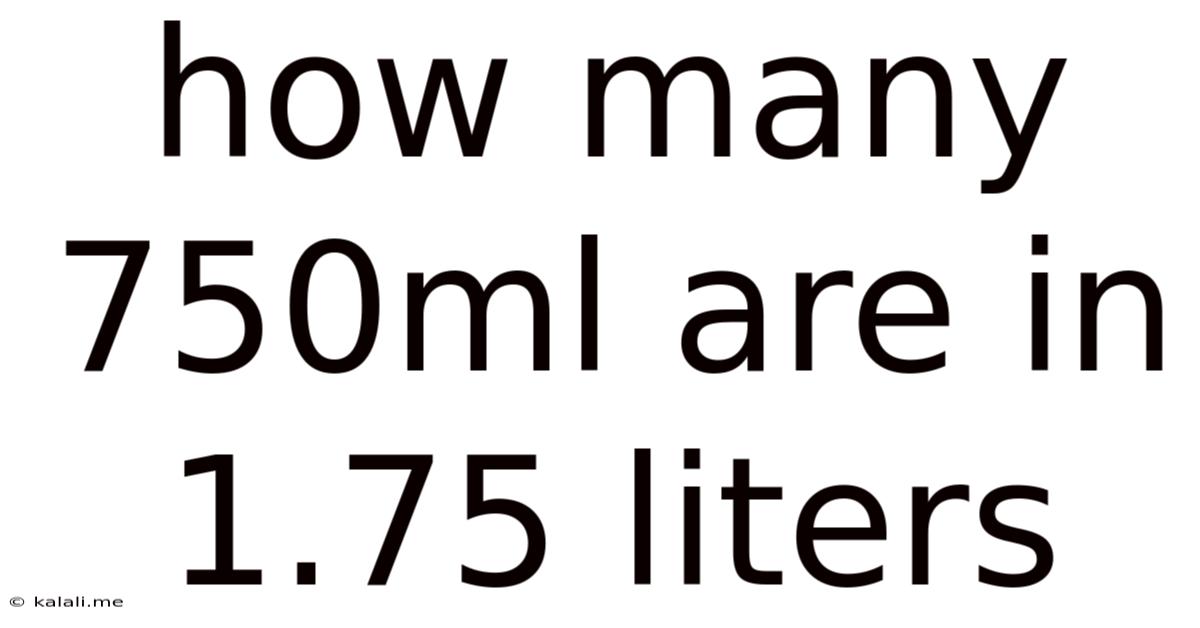How Many 750ml Are In 1.75 Liters
Kalali
Jul 05, 2025 · 4 min read

Table of Contents
How Many 750ml Bottles Are in a 1.75 Liter Bottle? A Comprehensive Guide to Volume Conversions
This article aims to answer the question: "How many 750ml bottles are in a 1.75-liter bottle?" While the answer might seem simple at first glance, understanding the conversion process is crucial for various applications, from planning parties to understanding wine bottle sizes and even industrial liquid handling. We'll delve into the calculation, explore common scenarios where this conversion is useful, and discuss related volume conversions to provide a comprehensive understanding of liquid measurements.
Understanding the Units: Liters and Milliliters
Before we begin the calculation, let's refresh our understanding of liters (L) and milliliters (mL). A liter is a metric unit of volume, commonly used to measure liquids. A milliliter is one-thousandth of a liter (1 L = 1000 mL). This fundamental relationship is key to performing accurate conversions.
The Calculation: From Liters to Milliliters
The first step in solving our problem is to convert the 1.75-liter bottle into milliliters. Using the conversion factor (1 L = 1000 mL), we simply multiply:
1.75 L * 1000 mL/L = 1750 mL
Therefore, a 1.75-liter bottle contains 1750 milliliters of liquid.
The Final Calculation: Determining the Number of 750ml Bottles
Now that we know the 1.75-liter bottle contains 1750 mL, we can determine how many 750 mL bottles are equivalent. We perform a simple division:
1750 mL / 750 mL/bottle = 2.33 bottles
This calculation reveals that a 1.75-liter bottle is equivalent to approximately 2.33 bottles of 750 mL.
Practical Implications and Real-World Scenarios
Understanding this conversion is crucial in numerous real-world situations:
-
Planning Events: If you're planning a party and need to buy enough wine, knowing that a 1.75-liter bottle (often called a magnum) is roughly equivalent to two standard 750ml bottles can help you estimate the required quantity accurately. You'll need to buy at least three 750ml bottles to match the volume of a single magnum.
-
Restaurant Management: Restaurants often purchase larger bottles of wine for cost efficiency. Knowing the conversion allows for accurate pricing and portioning for individual servings.
-
Home Brewing and Winemaking: Whether making wine or beer at home, accurately measuring ingredients is crucial. This conversion allows for scaling recipes from smaller batches to larger ones, or vice versa.
-
Industrial Applications: Many industries, such as pharmaceuticals and chemicals, deal with large volumes of liquids. Accurate conversions are essential for proper mixing, storage, and dispensing.
-
Scientific Research: In scientific experiments involving liquid solutions, precise volume measurements are critical for reproducible results. The ability to convert between different units ensures accuracy in the experiment.
Beyond 750ml: Exploring Other Common Bottle Sizes
While 750ml is a standard bottle size, several other sizes exist. Understanding their relationship to liters is equally important:
-
375ml (Half Bottle): This is half the size of a standard bottle, equivalent to 0.375 liters.
-
1500ml (Magnum): As mentioned before, a 1.5-liter bottle is a Magnum, containing double the volume of a standard bottle.
-
187ml (Piccolo): This is the smallest size of the more common wine bottle sizes, containing less than a quarter of a standard bottle.
-
Double Magnum (3L): Four times the size of a standard bottle.
-
Jeroboam (3L): Also a 3-liter bottle. The name varies based on context and the wine.
-
Rehoboam (4.5L): Six times the size of a standard bottle.
-
Methuselah (6L): Eight times the size of a standard bottle.
-
Salmanazar (9L): Twelve times the size of a standard bottle.
-
Balthazar (12L): Sixteen times the size of a standard bottle.
-
Nebuchadnezzar (15L): Twenty times the size of a standard bottle.
Mastering Volume Conversions: A Step-by-Step Guide
Here's a general approach to converting between liters and milliliters, or between different bottle sizes:
-
Identify the starting unit and the desired unit. For example, you might start with liters and want to end up with milliliters, or vice versa.
-
Find the conversion factor. The most important conversion factor is 1 L = 1000 mL. For other bottle sizes, you will need the respective volume in milliliters or liters.
-
Set up the conversion equation. Arrange the equation so that the units cancel out, leaving you with the desired unit.
-
Perform the calculation. This might involve multiplication or division, depending on the conversion.
Example: Convert 2.5 liters to milliliters.
-
Starting unit: Liters; Desired unit: Milliliters
-
Conversion factor: 1 L = 1000 mL
-
Conversion equation: 2.5 L * (1000 mL/1 L)
-
Calculation: 2500 mL
Conclusion: A Deeper Understanding of Volume
Understanding how many 750ml bottles are in 1.75 liters is more than just a simple conversion; it's a foundational concept for anyone dealing with liquid measurements. By mastering this calculation and understanding the broader context of volume conversions, you gain valuable skills applicable in various fields, from event planning and restaurant management to scientific research and industrial applications. Remember to always double-check your calculations to ensure accuracy and avoid any discrepancies. Understanding the conversion between different units of volume can significantly improve efficiency and accuracy across multiple aspects of life.
Latest Posts
Latest Posts
-
What Is A Singing Group Of 9 Called
Jul 06, 2025
-
How Long Is A 30 Mile Drive
Jul 06, 2025
-
How To Nter The Power Room In Riddle Transfer
Jul 06, 2025
-
Italian Name For Girlfriend On The Side
Jul 06, 2025
-
How To Say Spanish Food In Spanish
Jul 06, 2025
Related Post
Thank you for visiting our website which covers about How Many 750ml Are In 1.75 Liters . We hope the information provided has been useful to you. Feel free to contact us if you have any questions or need further assistance. See you next time and don't miss to bookmark.